5.Learning to Fly with Computers
RESOURCES - PUBLICATIONS
The Evolution of Spray Drones, Their Capabilities and Challenges for Pesticide Applications
5.LEARNING TO FLY WITH COMPUTERS
Each drone manufacturer has their own specific software for flight planning and controlling drone functions. Like much of agriculture’s new precision technology, drone technology requires skills to effectively operate and navigate computers. For some, this may be as simple as the interface and navigation systems. Most drone technology is not much different than other common software systems or computers and displays used in modern agricultural equipment.
However, for those who are not as tech-savvy, overcoming these technologies can be daunting. Some interfaces can be difficult to manage, and some operations may be difficult to troubleshoot in the field. These challenges are compounded by a lack of adequate product and software support in the industry.
In addition to the steep learning curves with the technology, employees need to thoroughly understand the federal and state laws that govern drone use for agricultural applications. The FAA, EPA, state regulatory offices, and local governments can all be involved with creating and enforcing the rules that surround the use of spray drones. Some of those rules can be confusing, conflicting, or generally unclear because the rules and laws are continuously being updated to account for this novel technology. The good news is it should be easier to find eager employees who have both drone and computer experiences as the technology becomes more popular and widespread.
DRONE FACT : If you are interested in hiring a custom spray drone applicator, be sure to ask if the applicator is fully licensed and insured specifically for spray drone applications.
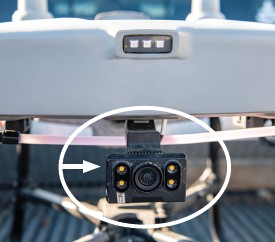 This DJI Agras T10 has a camera in the front and is flanked on either side by an obstacle avoidance sensor.
This DJI Agras T10 has a camera in the front and is flanked on either side by an obstacle avoidance sensor. 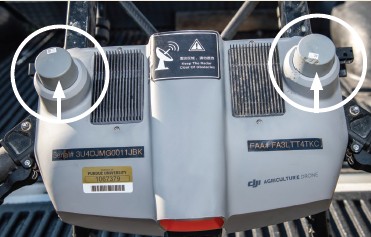 The drone receives a signal from the controller via its two antennae. The two black panels on the side of the receiver allow air flow that helps keep the hardware in the drone from overheating.
The drone receives a signal from the controller via its two antennae. The two black panels on the side of the receiver allow air flow that helps keep the hardware in the drone from overheating. 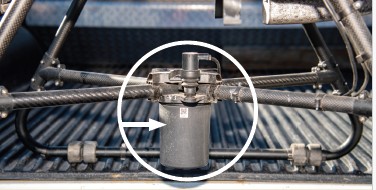 This device is called an omnidirectional digital radar system. It measures the altitude that is recorded on the controller.
This device is called an omnidirectional digital radar system. It measures the altitude that is recorded on the controller. 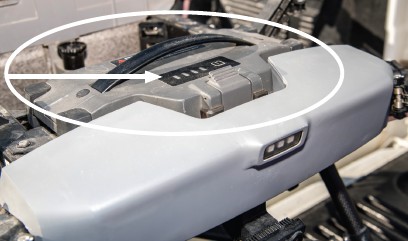 This battery snaps into place. The four light panels on the battery indicate how much battery life remains.
This battery snaps into place. The four light panels on the battery indicate how much battery life remains. 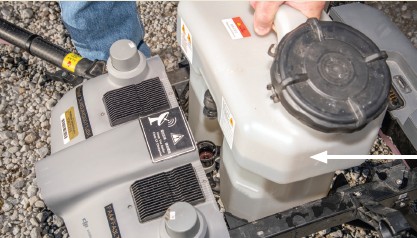 This drone’s tank holds 2.5 gallons.
This drone’s tank holds 2.5 gallons. 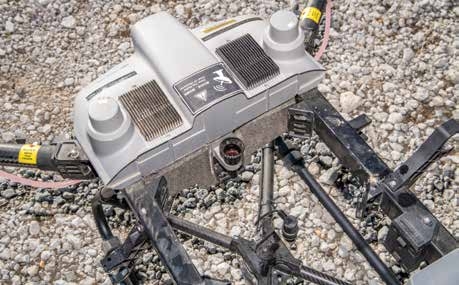 The drone with the spray tank removed.
The drone with the spray tank removed. 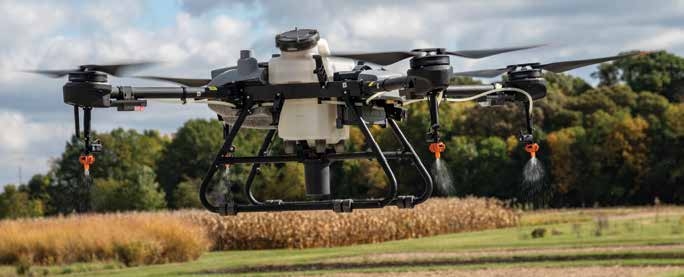 This drone has four nozzles. When flying autonomously, only the nozzles in front of the travel direction turn on for spraying. In other flight mode types and higher application rates, the drone can turn on additional nozzles.
This drone has four nozzles. When flying autonomously, only the nozzles in front of the travel direction turn on for spraying. In other flight mode types and higher application rates, the drone can turn on additional nozzles.